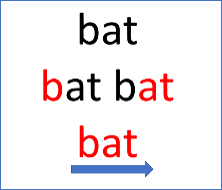Blending explained with examples, the best way to teach blending and tips to help struggling children…
Contents:
- What is the Definition of Blending in Phonics?
- Phonological/Phonemic Awareness Blending vs Blending in Phonics
- What’s the Difference Between Blending and Segmenting?
- Should Blending or Segmenting be Taught First?
- When Can a Child Begin Blending Words?
- What’s the Difference Between Decoding and Blending?
- What’s the Best Way to Teach Blending Sounds?
- How to Teach Blending Sounds for Phonics
- Examples of Blending Different Types of Words
- Helping Children with a Difficulty in Blending Sounds in Words
- Smooth/Continuous Blending
- Further Information…
What is the Definition of Blending in Phonics?
Blending in phonics means merging the individual speech sounds represented by letters to make spoken words.
A key idea that underpins phonics instruction is that spoken words are made up of individual sounds known as phonemes. Children are first taught how to identify the sounds represented by the letters in a printed word (this is known as decoding).
They are then taught to blend the sounds together by saying them more quickly in order. The aim is to reduce the gaps between the sounds until they merge to make a word. Children should then be able to identify the word if it’s part of their spoken vocabulary.
It’s important that children know how to blend sounds to read words if they are being taught using a synthetic phonics approach. Some educators use the term ‘synthesizing’ as an alternative to blending, but both words have the same meaning in phonics.
The short video below explains blending quite clearly:
And this next video shows how blending can be explained to young children:
Phonological/Phonemic Awareness Blending vs Blending in Phonics
Phonological awareness blending is similar to blending in phonics because they both involve merging sounds together to make words.
However, in phonological awareness instruction, blending is often done as a verbal/aural exercise, without any written words. In contrast, blending in phonics instruction is normally done in the context of printed words.
Ultimately, both types of blending develop the same skills and they are taught with the same purpose in mind – to help children read.
What’s the Difference Between Blending and Segmenting?
Blending involves combining individual sounds to make words and segmenting involves dividing words up into individual sounds.
So, segmenting is like blending in reverse. Both procedures require good phonemic awareness skills.
Should Blending or Segmenting be Taught First?
Most children find blending sounds easier than segmenting words, so it’s probably best to start with blending. However, since the two procedures are closely related, practising one skill complements the other.
Consequently, it makes sense to introduce segmenting shortly after blending and then teach the two skills alongside each other.
When Can a Child Begin Blending Words?
Some academics claim that children aren’t capable of blending until they are around 5 years old, but one study found that 93% of 3-year-olds could blend speech sounds into words.
Chaney (1992) – study information accessed from Jolliffe, W., Waugh, D. Carss, A. (2015) Teaching Systematic Synthetic Phonics in Primary Schools, SAGE publications.
It’s likely that there’s no exact age that’s ideal for all children because there is considerable variation in the development and temperament of individual children of the same age.
Both of our own children were able to blend simple words before they were 2 years old and more complex words by the time they were 3.
Of course, children won’t be able to blend written words until they are familiar with the sounds represented by the letters. But they don’t need to have done oral blending before they blend printed words. See ‘What’s the Best Way to Teach Blending?‘ below in this article.
Also, children don’t need to know the sound of every letter in the alphabet before they can start blending.
In fact, many popular phonics programmes introduce blending after only a handful of letters have been introduced. The letters that make up ‘satpin’ are a popular choice because a variety of small words can be made from these:
at, in, it, sat, sit, pat, pit, etc.
Some people claim that introducing activities like blending before the age of 5 could be harmful to children’s development, but we haven’t seen any convincing evidence or reasons for this.
We discuss this point and other concerns in our ‘arguments against early reading instruction’ article.
Our opinion is that introducing blending for kindergarten or preschool children is likely to do more good than harm, as long as sessions are kept brief and done in a playful way.
What’s the Difference Between Decoding and Blending?
Decoding is the process of identifying the spoken sounds represented by individual letters or groups of letters.
Blending involves combining speech sounds to make words.
Expert readers can identify and read whole words without having to blend sounds or consciously think about the processes involved. The ability to identify whole words in this way could also be described as decoding.
What’s the Best Way to Teach Blending Sounds?
Blending is a skill that’s based on phonemic awareness, and studies show that children develop phonemic awareness and blending skills more quickly when they practise them using printed words. Consequently, it makes sense to introduce blending during phonics instruction after children have learned some letter sounds.
Practising blending as a speaking and listening exercise before children are introduced to printed letters won’t do any harm, but it’s more beneficial to blend the sounds represented in written words from the start.
Also, blending in the absence of print is an incredibly abstract idea. It’s much easier for children to understand the point of blending when can see that it helps them to read written words.
See our passage, ‘Should Phonemic Awareness be Taught Without Letters?’ for more information on this.
As we mentioned earlier in this article, teaching children how to segment words for spelling can also help to improve their ability to blend because both skills involve identifying and manipulating the sounds in words (phonemic awareness).
Practising segmenting alongside blending can help children to understand that one process is the reverse of the other, and this can give them a deeper understanding of how words are constructed using the alphabetic code.
How to Teach Blending Sounds for Phonics
We explain blending in detail in our main article on how to teach phonics and we’ve provided examples of blending a variety of words below. If you have a child who struggles to blend words, you might want to try an alternative strategy such as smooth blending, which we describe later in this article.
Examples of Blending Different Types of Words…
Blending to Read 3-Letter Words
Many 3-letter words, such as ‘cat’, ‘dog’, ‘pan’ and ‘hot’, are described as CVC words because they have a consonant which is followed by a vowel and then another consonant.
To blend CVC words, a beginning reader would normally vocalise the sounds represented by each letter in turn, with a pause between each one. This is sometimes called ‘sounding out’.
After identifying each sound, they then say the sounds more quickly in succession, so they merge to form the word. The illustrations below summarise the process. The red letters are the ones that are sounded out at each stage:
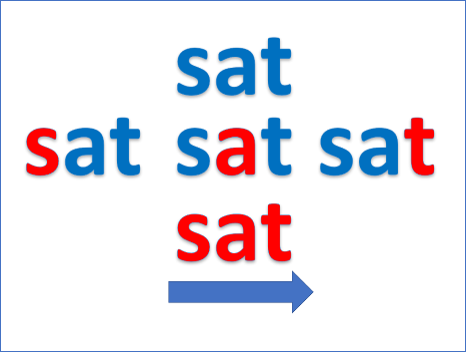
Blending Word Families…
Teachers sometimes group words with similar letter and sound patterns together and introduce them to children as ‘word families’. There may be some advantage in doing this because it allows children to become familiar with common letter patterns.
There is evidence that our brains are especially good at identifying letter pairs, which are known as bigrams*.
*See Dehaene, S. (2009), Reading in the Brain, Penguin Books.
Learning about word families could help children identify and blend some common bigrams as single units.
For example, after blending the word ‘sat’ shown above, a teacher might draw a child’s attention to the letter pair ‘at’, and then introduce other words with this letter pattern such as bat, cat, fat, hat, mat, pat, and rat. A child might then be able to blend these words as indicated in the illustrations below.
| 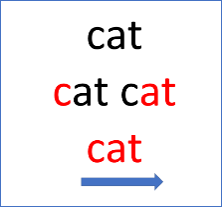 | 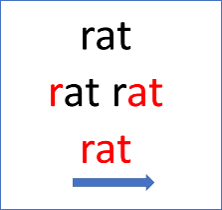 |
This type of blending is sometimes called onset-rime blending and it’s potentially more efficient than blending each letter separately. However, it’s important to show children how to blend individual phonemes first or they won’t be able to read words with unfamiliar letter patterns.
Whether you choose to teach onset-rime blending or not, children do gradually recognise common letter patterns after lots of practice, and they will eventually be able to process a whole string of letters without having to consciously think about blending.
See our free printable CVC word lists for a variety of words to use for blending CVC words practice. Our short vowel lists contain common word families.
Many common 3-letter words aren’t CVC words. For example, ‘ant’, ‘and’, ‘end’, and ‘off’ don’t have the CVC pattern. Some teachers say that children find blending these words more difficult because they contain adjacent consonants.
However, most children can overcome any initial difficulties if they are given clear demonstrations by the teacher along with plenty of practice.
The process for blending these simple 3-letter words is the same as for blending CVC words. For example:
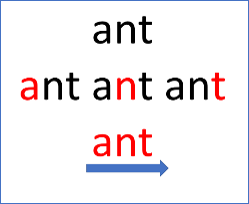
The word ‘off’ contains a digraph, so it’s important to explain to children that 2 letters can sometimes stand for one sound. | 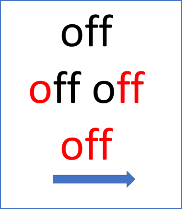 |
Blending 2-syllable words
The procedure for blending multi-syllable words is the same as for blending one-syllable words; however, words with more than one syllable are generally more challenging because they are often longer.
Another complication is that the correct pronunciation of multi-syllable words depends on how much each syllable is stressed. But you can’t be sure you’ve stressed the syllables correctly until you know what the word is!
Fortunately, this problem can usually be solved by engaging in a little trial and error.
See our article about the schwa sound for more information about syllable stress.
Of course, it’s helpful for children to have an understanding of what syllables are before they start to blend multi-syllable words in print. We discuss how to teach syllables in our article on phonological awareness activities for parents and teachers.
Children should be able to blend one-syllable words reasonably well before they’re introduced to 2-syllable words. And it’s important to give them words that are suited to their current level of phonics knowledge.
Blending 2-syllable words can be easier for children to grasp if you introduce simple compound words first because they find it easier to recognise each syllable in these words.
It’s best to start with words where each letter represents its most common sound. We’ve provided some examples of suitable words below and you can download our free list of 2-syllable words.
bedbug desktop hotdog sunset suntan backpack himself sandpit setback uphill windmill
You can also use a variety of other simple 2-syllable words that have regular spellings…
bucket button cabin camel carrot cobweb cotton dentist dragon helmet jacket kitten lemon liquid mattress medal napkin nickel packet pedal petal picnic plastic pocket pumpkin rabbit ribbon robin salad velvet wagon
There are lots of other 2-syllable words you can use if the children you teach are already familiar with digraphs and the alternative sounds for vowels:
apron, bacon, postman, playground, blackbird, baseball, rainbow, teacup, cupcake, snowball, toothbrush, houseboat, cardboard, cheesecake, fireplace, horseshoe, keyhole, sunrise, football, popcorn, pancake, toenail, starfish, bathtub, bedroom, earache, daylight, eggshell, highchair, teaspoon, goldfish, birthday, peanut, earthquake, playdough, upstart
Some teachers believe that it can be helpful for blending if children understand the rules for splitting syllables. We haven’t found this to be necessary, although there may be some benefit in teaching these rules.
We haven’t really experimented with syllable rules because the UK National Curriculum doesn’t specify that children need to learn all the various types of syllables. Also, we wonder whether some of the rules could be a bit confusing for beginning readers.
For example, written words with double consonants, such as rabbit, are normally split between the consonants: rab–bit according to syllable splitting rules. Yet, this doesn’t correspond with the way the word is spoken because it implies the /b/ sound is said twice, when, in fact, the two letter bs act as a digraph and only represent one sound.
Nevertheless, if you’re a teacher you have to follow the curriculum in your own region, and we can see how splitting the syllables in this way could help children remember there are 2 letter bs when they are segmenting words for spelling.
Blending digraphs
The most important point to teach children about blending words with digraphs is that the letters in a digraph represent a single phoneme (unit of sound). Apart from that, the blending process is the same as in other words.
It can help to highlight the digraph letters in some way when children are first introduced to words with new digraphs. For example, if you wanted a child to blend words containing the ‘ch’ digraph, you could either write the digraph letters in a different colour or underline them:
chat chips chin much such
or
chat chips chin much such
After they’ve practised a set of words a few times, you can remove the ‘scaffolding’ and get the child to blend words where the digraphs haven’t been highlighted. You can also look out for words in books with digraphs you’ve taught and ask them to read these words.
Finally, it can be helpful to point out that digraphs can represent different sounds in some words. For example, the ‘ch’ digraph illustrated above represents alternative sounds in words such as anchor and chef.
You can see examples of the alternative sounds for a range of vowel digraphs and consonant digraphs in our digraph article.
Blending Tricky Words/Common Exception Words
Tricky words, or common exception words, contain irregular spelling patterns for some sounds, so they are more difficult to blend. Nevertheless, the majority of these words contain some regular letter-sound relationships, and it is possible for children to blend them once they are aware of the irregular spelling.
We discuss how children can be taught to blend tricky words in a systematic way in our article on teaching phonics.
Helping Children with a Difficulty in Blending Sounds in Words
Many beginning readers have some problems with blending at first. For example, they might sound out the letters correctly but then say a completely different word when they try to blend the sounds.
Other children can blend fairly accurately from the beginning, but they might be very slow – labouring over every word.
Most of these problems should disappear after a few weeks of regular practice, but if a child can’t blend simple words after several sessions, they might need some extra instruction and practice. If possible, this should be in addition to their normal phonics classroom sessions.
According to the distinguished researcher Professor Timothy Shanahan, providing more instruction is the most important thing you can do to help struggling readers:
“Research suggests that amount of instruction is the single most important alterable determinant of learning.”
Shanahan, T. University of Illinois at Chicago What Research Says about Teaching Children to Read
Of course, the type of instruction also matters. This should involve clear modelling of the blending process followed by plenty of examples for the children to practice and they should get immediate feedback and support where necessary.
Ideally, the extra teaching and practice should be spaced out over several short sessions rather than crammed into one session. Three 20-minute sessions during the week should give better results than a single session of 1 hour.
If finding time in a school setting is an issue, getting parents to help at home can really make a difference. However, they are likely to need clear guidance about what they are expected to do. A short meeting would be ideal, but if that’s not possible, sending them a video demonstration could also be helpful.
In addition to spending extra time, you might also need to go back to basics and try some other strategies…
- Firstly, make sure the child has fully mastered the letter-sound correspondences. John Walker, creator of the successful Sounds-Write phonics course has stated:
“If children can talk, they can blend sounds to form words. If they can’t blend when they’re learning to read, it’s probably because, for one reason or another, they need much more practice in connecting spellings to sounds.”
Walker, J. Can’t blend, won’t blend. The Literacy Blog.
- Firstly, make sure the child has fully mastered the letter-sound correspondences. John Walker, creator of the successful Sounds-Write phonics course has stated:
Children should be able to say the relevant sound for each letter without any hesitation. If they confuse letter sounds with letter names, stop using the letter names in your teaching as they aren’t helpful for beginning readers learning to blend.
It’s also important for the child and teacher to pronounce the sounds correctly. It’s very easy to add an ‘uh’ (schwa) sound to some consonants but doing this makes it harder to blend words. The short video below explains the correct pronunciation of sounds clearly:
Use the following link to access a variety of Free Online Games for Letter Sounds.
Note that children don’t have to master oral blending before trying to blend printed words. In fact, the blending process is easier to learn and understand with letters than it is as a purely aural/oral exercise. See our passage, ‘Should Phonemic Awareness be Taught Without Letters?‘
- Stick to simple vc, and cvc words containing short vowel sounds at first and only move on to more complex words once your child has mastered these.
Use visual aids such as magnetic letters, alphabet blocks or letter cards to show a physical representation of blending.
Start off with the letters of a word spaced apart from each other and say the sound represented by each letter with a pause between each sound. Next, move the letters a bit closer and say each sound again, but with less of a pause between each one.
Gradually push the letters closer together, reducing the pause each time until the letters are touching, then say the whole word.
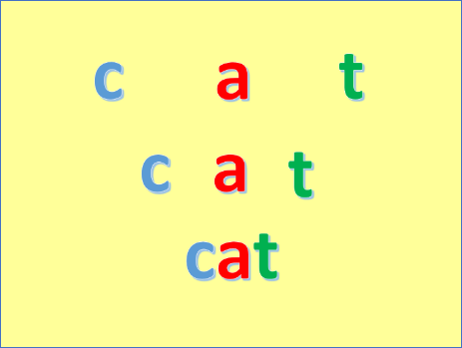
- Practise segmenting alongside blending. This is important because the 2 processes are closely related and practising one skill strengthens the other.
You can segment some of the words you’ve blended using magnetic letters to illustrate that the 2 processes are reversible.
- Incorporate games and activities into your instruction to make it fun. These can help because the variety increases engagement and motivation and it’s much easier to learn with a positive frame of mind. Follow this link to our article on Phonemic Awareness/Phonics Blending Activities and Games.
- Try Smooth/Continuous blending. We describe this in detail below…
- Practise segmenting alongside blending. This is important because the 2 processes are closely related and practising one skill strengthens the other.
Smooth/Continuous Blending
This is an alternative approach to blending that focuses on ‘stretching out’ and holding sounds as you move from one letter to the next. You don’t pause between each letter sound with this technique; instead, you try to smoothly transition from one sound to the next.
Smooth blending is similar to other techniques described as ‘Blend as You Read’, ‘successive blending’, ‘continuous blending’ or ‘sound-by-sound blending’.
The technical name for smooth blending is ‘connected phonation’ and it’s been shown to be more effective than regular blending (segmented phonation) in some studies such as the one you can access from this link:
Exaggerate and hold each sound for longer than normal when you first introduce this technique. Then say the sounds again, holding them for a shorter time before finally saying the word in the normal way. For example:
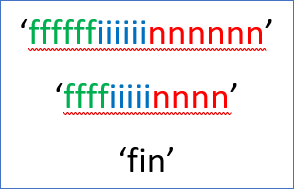
There are no gaps between the sounds in smooth blending. This contrasts with the more common approach where we say an individual letter sound and then pause before saying the next letter sound:
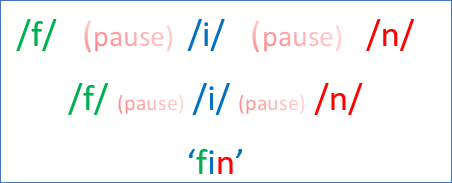
The advantage of smooth blending is that the sounds merge in a more natural way like they do in normal speech, so it’s easier for children to hear the words.
It’s best to introduce smooth blending with words that are made up of continuous sounds. These are sounds that can be emphasised by stretching them out for a few seconds, so they are easier for children to hear. For example, ‘ffffffff…’, ‘mmmmm…’, ‘rrrrrrr…’ or ‘ssssss’.
See our article about continuous sounds for a more detailed explanation and further examples.
Words such as ‘fan’, ‘fin’, ‘fun’, ‘man’, ‘ran’ ‘van’, ‘run’ and ‘sun’ would be fine to use as early examples of CVC words.
You could introduce the technique with a VC word first and then add a continuous consonant to make a CVC word.
For example, you could blend the word ‘am’ in the following way:
‘aaaaaammmmmm’
‘aaammm’
‘am’
Then add the letter ‘r’ at the start:
‘rrrrrraaaaaammmmmm’
‘rrraaammm’
‘ram’
After doing words that are composed entirely of continuous sounds, you can move on to words that start with continuous sounds but contain stop sounds at the end. For example, ‘fat’, ‘fit’, ‘map’, ‘mud’, ‘nap’ and ‘rat’.
Finally, you can introduce words that start and end with stop sounds such as ‘bag’, ‘cat’, ‘dog’, ‘pet’, ‘tip and ‘top’.
We’ve made a list of CVC words that you can print off to use for smooth blending practice. You can access these from the following link:
CVC Words for Smooth/Continuous Blending.
You might also find it useful to view the video below to see a demonstration of smooth blending:
Follow this link to the E.P. Toolbox site for a more detailed description of teaching smooth blending and there’s a very thorough and well-researched article that discusses similar ideas on the Reading Simplified site.
Some other strategies can be incorporated into smooth blending practice to make it more fun and effective. For instance, the idea of using a toy car to move from one letter/sound to the next. See the video for ‘drive through blending’ below:
And using a piece of string with knots in it could also be used as a multisensory aid to a smooth blending strategy. You can see how this might work in the video below, but as we indicated earlier, it’s best to use words that start with continuous sounds when you introduce smooth blending.
One final point. We think it’s best to avoid alternative methods of identifying words when kids are struggling with blending. This includes rote learning so-called sight words and multi-cueing strategies such as guessing words from the context or pictures during reading practice.
Encouraging these methods can give children mixed messages about how they should try to read words and if they are using predictable and repetitive texts they might think they don’t need to worry about mastering blending. Alternative strategies are much less reliable when children move onto more complex and less predictable storylines without illustrations.
Further Information:
This video summarises some of the ideas we’ve mentioned in this article:
For phonemic awareness/phonics blending worksheets, follow this link to our free phonemic awareness/phonics blending activities and games…
A variety of free downloadable activities and games to improve phonics blending skills. CVC words and words containing adjacent consonants/consonant blends.
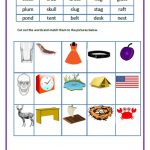
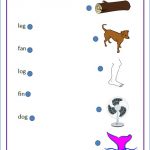
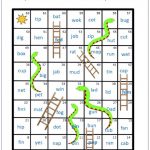
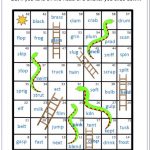
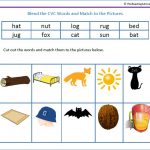







We’ve also compiled and reviewed a selection of free blending games online.
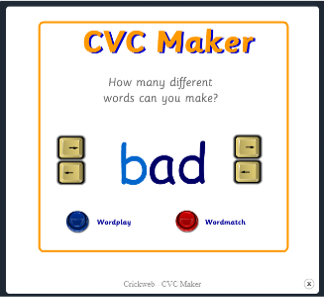 | 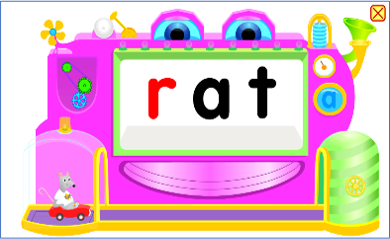 | 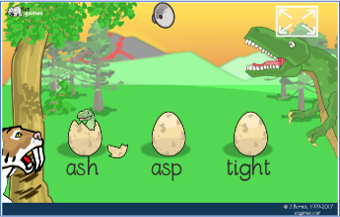 |
